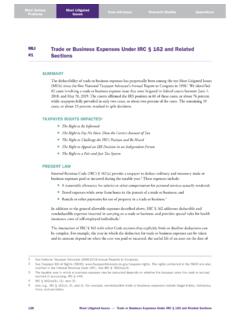Transcription of Guidelines for Business Case Analysis
1 Guidelines for Business case Analysis Prof. Dr. Christoph Rasche Dr. Achim Seisreiner University of Potsdam Adopted from Harvard Business School and adjusted to the European diction of strategic management Rasche/Seisreiner: Guidelines for Business case Analysis 2/12 Content I. Introduction 3 II. A case Analysis Framework 3 A. Analyze and Record the Current Situation 4 B. Analyze and Record Problems and Their Core Elements 7 C. Formulate, Evaluate, and Record Alternative Courses of Action 8 D.
2 Select, Implement, and Record the Chosen Alternative Course of Action 8 III. Guidelines for an Operational Approach to case and Problem Analysis 8 IV. Pitfalls to Avoid in case Analysis 9 V. Communicating case Analyses 10 A. The Written Report 10 B. The Oral Presentation 12 VI. Conclusion 12 Rasche/Seisreiner: Guidelines for Business case Analysis 3/12 I. Introduction Cases assists in bridging the gap between classroom learning and the so-called real world of management. They provide us with an opportunity to develop, sharpen, and test our analytical skills at: - Assessing situations.
3 - Sorting out and organizing key information. - Asking the right questions. - Defining opportunities and problems - Identifying and evaluating alternative courses of action. - Interpreting data. - Evaluating the results of past strategies. - Developing and defending new strategies. - Interacting with other managers. - Making decisions under conditions of uncertainty. - Critically evaluating the work of others. - Responding to criticism. The use of Business cases was developed by faculty members of the Harvard Graduate School of Business Administration in the 1920s.
4 case studies have been widely accepted as one effective way of exposing students to the decision-making process. Basically, cases represent detailed descriptions or reports of Business problems. They are usually written by a trained observer who actually had been involved in the firm or organization and had some dealings with the problems under consideration. Cases generally entail both qualitative and quantitative data which the student must analyze and determine appropriate alternatives and solutions. The primary purpose of the case method is to introduce a measure of realism into management education.
5 Rather than emphasizing the teaching of concepts, the case method focuses on application of concepts and sound logic to real-world Business problems. In this way the student learns to bridge the gap between abstraction and application and to appreciate the value of both. The primary purpose of this paper is to offer a logical format for the Analysis of case problems. Although there is no one format that can be successfully applied to all cases, the following framework is intended to be a logical sequence from which to develop sound analyses.
6 This framework is presented for Analysis of comprehensive management cases; however, the process should also be useful for shorter cases, incidents, and problems. II. A case Analysis Framework A basic approach to case analyses involves a four-step process. First, the problem is defined. Second, alternative courses of action are formulated to solve the problem. Third, the alternatives are analyzed in terms of their strengths and weaknesses; and fourth, an alternative is accepted and a course of action is recommended.
7 This basic approach is quite useful for the student well versed in case Analysis , particularly for shorter cases or incidents. However, for the newcomer this framework may well be inadequate and oversimplified. Thus, the following expanded framework and checklists are intended to aid the student in becoming proficient at case and problem Analysis . Rasche/Seisreiner: Guidelines for Business case Analysis 4/12 A. Analyze and Record the Current Situation Whether the Analysis of a firm s problems in done by a manager, student, or paid Business consultant, the first step is to analyze the current situation.
8 This does not mean writing up a history of the firm but entails the type of Analysis described below. This approach is useful not only for getting a better grip on the situation but also for discovering both real and potential problems the central concern of any case Analysis . Phase 1: The environment. The first phase in analyzing a management problem or case is to consider the environment in which the firm is operating. The economic environment can have a decided effect on an industry, firm, and management program.
9 For example, a depresses economy with high unemployment may not be an ideal situation for implementing a large price increase. The social and cultural environment also can have considerable effect on both multinational and domestic firms. For example, the advent of men s hairstyling could be considered an appropriate reaction to today s longer hairstyles, whereas a price reduction to stimulate demand for haircuts could well be inappropriate. Phase 2: The industry. The second phase involves Analysis of the industry in which the firm operates.
10 This phase can be critical, particularly in terms of how the firm s product is defined. A too-narrow definition of the industry and competitive environment can be disastrous not only for the firm but also for the individual analyzing the case . In appraising the industry, it is useful to first categorize it by the Standard Industrial Classification (SIC) and in terms of the accompanying list (figure 1). After initial definition and classification, attention should be paid to such factors as: 1.







